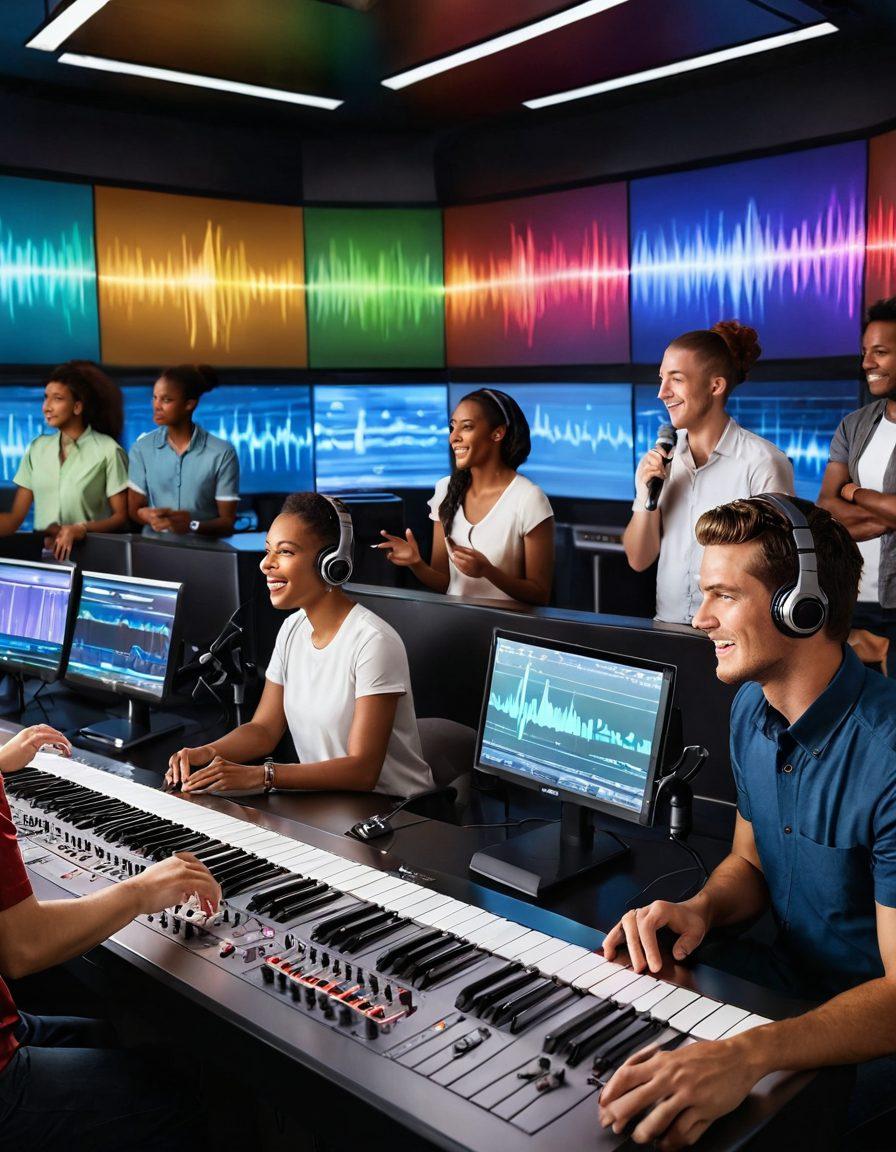Unlocking the Art of Voice Modeling: Techniques for Better Communication and Audio Production
In today's fast-paced world, mastering the art of voice modeling is more crucial than ever before. Whether you're a budding voice actor looking to break into the audio production industry or simply someone striving to enhance your public speaking skills, you may be pondering, 'How can I improve my communication through my voice?' Voice modeling isn't just a skill; it's an art that enables you to engage your listeners through your intonation, diction, and articulation. Imagine the power of your voice, capable of narrating compelling stories or delivering impactful speeches with a captivating sound that resonates with your audience. Let's dive deeper into some essential techniques that will elevate your communication to new heights.
At the heart of effective voice modeling lies the understanding of sound and phonetics. Every sound we make carries meaning, and mastering the nuances of vocalization can lead to extraordinary results. For instance, consider how a slight change in intonation can transform a simple statement into an engaging dialogue. As the famous voice actor Don LaFontaine once said, "It’s not about the voice, it’s about how you use it." This encapsulates the essence of voice modeling—how you project your emotions and intent through speech synthesis. The journey begins with voice training; invest time in exercises that hone your vocal range and clarity. Utilize methods like breath control and warm-ups to make your voice more versatile and expressive.
Now, let's talk about the importance of storytelling in audio production. Imagine being transported into a world where every word spoken paints a vivid picture in the listener's mind. This is the magic of audio storytelling, and it can be harnessed through effective voice modeling techniques. Think about how great narrators captivate their audiences; they don't just read words, they bring them to life. Incorporate elements of sound design to your narration, blending your voice with sound effects and music to create an immersive experience. Ask yourself, how do I want my audience to feel with each word I speak? Craft your stories with intention, and your voice will become the bridge that connects your message to their hearts.
For those engaged in dialogue or voice-over acting, the significance of articulation and diction cannot be overstated. Each word counts in ensuring your message is not lost. Have you ever noticed how some speakers seem to speak effortlessly with clarity, while others may leave you guessing? This is where voice therapy and proper training come into play. Invest in exercises that help you pronounce difficult words, enunciate with precision, and refine your vocal delivery. Record yourself and listen attentively—what can you improve? Engaging in consistent practice will not only boost your confidence but also elevate the quality of your oral communication. Remember, even the greatest speeches undergo a rigorous process of refinement; your voice deserves just the same attention.
Lastly, as you embrace the world of voice modeling, let’s not forget the beauty found in imperfections. Often, it is the unique tones and sounds of our voices that create authenticity and relatability. In a world filled with synthesized perfection, genuine expression stands out. As you venture constantly into the realms of voice acting and audio editing, remind yourself that every scratch, soar, or quiver has the potential to convey emotion. So, let your voice be a reflection of your journey, your stories, and your passion. After all, communication is more than merely exchanging words; it’s about connecting deeply with others. With these techniques in your arsenal, the art of voice modeling awaits you, inviting you to explore, learn, and, most importantly, share your remarkable voice with the world.
The Science Behind Sound: Elevate Your Audio Production and Voice Skills
In the landscape of audio production and voice communication, sound is not merely a physical phenomenon; it’s an art intertwined with science. Imagine you’re standing in front of an audience, your words masterfully crafted, each intonation finely tuned, resonating with the listeners. Sound—the essence of communication—can be transformed into a powerful tool through voice modeling. Have you ever wondered how some people can captivate an entire room just with their voice? The answer lies in understanding the science behind sound, and how we can elevate both our audio production and voice skills.
Voice modeling is a fascinating process involving the creation of simulated voices and sounds that can mimic human vocalization. This technique extends beyond mere imitation; it also incorporates elements of phonetics and linguistics to enhance articulation and diction. By dissecting how sounds are produced and perceived, we gain insight into effective speech synthesis. Whether you’re narrating a story, delivering a speech, or engaging in voice acting, mastering the nuances of sound can profoundly impact your communication effectiveness. Quite often, the smallest changes in intonation can shift the emotional undertone of your message—have you been mindful of how you articulate your thoughts?
Consider the world of audio storytelling, where the voice plays a pivotal role in shaping narratives. Think about your favorite podcast or audiobook; what captivates you? Is it merely the story, or is it the way the narrator brings characters to life through expressive speech? This is where voice training comes into play. By honing your vocal skills—understanding acoustics, mastering voice therapy techniques, and practicing oral communication—you can transform the ordinary into the extraordinary. It’s about creating an experience that resonates with the audience and ignites their imagination.
But how do you embark on this journey to improve your voice skills? Start by embracing the fundamentals of audio production and sound design. Practice audio editing techniques that allow you to manipulate sound to fit your vision—after all, it’s as much about the delivery as it is about the content. Explore different genres of sound engineering to find what resonates with you. And don’t forget the power of dialogue; learning how to craft realistic conversations can drastically enhance your narration skills.
As you venture into the realm of voice modeling, remember: the journey is just as important as the destination. With each practice session, you’re not merely shaping your vocal abilities; you’re crafting your identity as a communicator. Whether you’re preparing for public speaking or diving deep into the world of voice over, the skills you develop will not only elevate your audio production capabilities but also transform how you connect with others. So, are you ready to unlock the limitless possibilities of your voice?
From Phonetics to Performance: A Comprehensive Guide to Voice Modeling
Voice modeling is an intriguing art form that combines the science of phonetics with the performance skills of vocal expression. Whether you’re a burgeoning voice actor, a public speaker, or someone looking to enhance their communication skills, mastering the art of voice modeling opens innumerable doors in both personal and professional arenas. Think of voice modeling as a bridge between the technicalities of sound and the magic of storytelling. What if I told you that with the right techniques, anyone can elevate their vocal performance to mesmerizing heights?
Deep diving into the world of phonetics reveals how sounds are formed and how we can manipulate them for effective communication. Linguistics plays a critical role here, helping us understand the essence of articulation, intonation, and diction. Have you ever wondered why some speakers captivate their audience while others fall flat? It often boils down to their ability to model their voice effectively. This involves recognizing the nuances of their speech and experimenting with different vocalizations to find their unique sound. With practice, anyone can learn to make their voice a powerful tool in audio production and storytelling.
At the heart of voice modeling lies the importance of vocal training. This not only strengthens your voice but also enhances your ability to project emotions and intentions during narration or dialogue. Remember that famous quote by vocal coach Susan Cain? "The loudest voices are often not the most powerful." Effective voice modeling takes advantage of the subtleties of sound design. It’s about using your voice to tell a story, engaging with your audience through expressive speech rather than mere words. How can you start your journey in voice training? One actionable step is to record your own speech and analyze it. Focus on clarity, pacing, and how your emotions come across in your vocal delivery!
Delving into the technical side of audio, the world of sound engineering comes into play. Understanding how to manipulate sound through audio editing can significantly enhance your voice modeling skills. Whether you want to explore speech synthesis or engage in audio storytelling, having a grasp of how audio production works is essential. Can you imagine the possibilities when you combine a solid understanding of acoustics and voice modulation? Every sound can have its own character, and you can learn to shape that character with deliberate choices in your vocal delivery, making each narration or voice-over a unique piece of art.
Voice therapy is another critical component that shouldn't be overlooked in the world of voice modeling. For many, challenges like speech impediments or vocal strain can hinder their potential in oral communication. By seeking professional guidance in voice therapy, one can work on improving vocal techniques, leading to stronger communication skills. You might ask, "How can I ensure that my voice remains healthy while engaging in all this practice?" Remember to stay hydrated, warm up your vocal cords, and allow time for rest. Whether it's a presentation or an audio production project, nurturing your voice is key to performing at your best. As you embark on this enriching journey of voice modeling, you’ll find that your capacity for effective communication expands exponentially, transforming mundane interactions into impactful dialogues.


